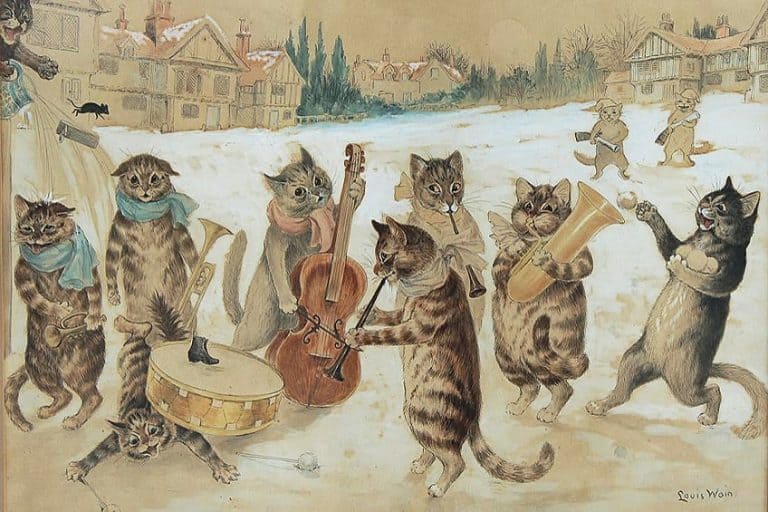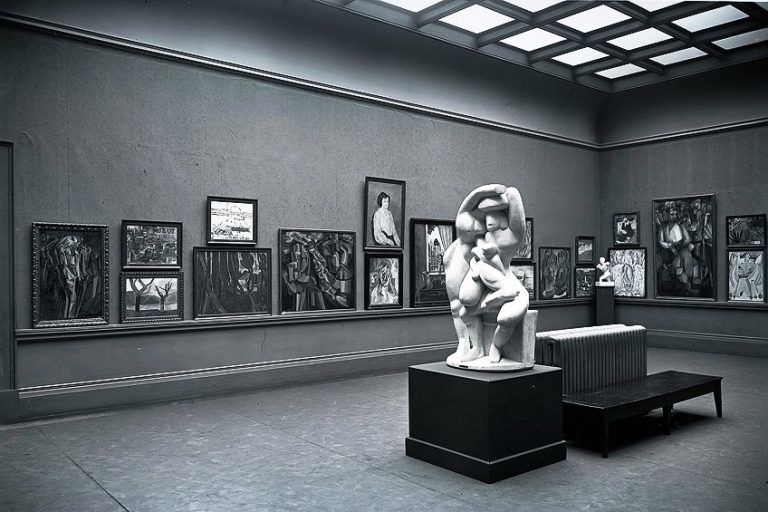Marc Chagall – His Cubist, Fauvist, and Surrealist Dreamworlds
Marc Chagall’s beautiful, figurative approach established him as among the most beloved modern painters, and his diverse production established him as one of the most widely renowned. While many of his contemporaries explored grandiose experimentation that sometimes led to abstraction, painter Chagall’s distinguishing feature was his unwavering trust in the potency of figurative art, which he retained while assimilating concepts from Cubism and Fauvism. Marc Chagall’s paintings were produced in many modern styles including Surrealism, Suprematism, and Cubism.
Marc Chagall’s Biography and Art
Where was Marc Chagall born and what is Marc Chagall most known for? We will attempt to answer these questions and many more about this extraordinary artist. All through his life, painter Chagall’s Jewish heritage was significant to him, and much of his output might be defined as an effort to integrate historic Jewish customs with contemporary art forms.
The rising Surrealists regarded Chagall as a kindred soul, and while he drew from them, he eventually discarded their more intellectual subject matter. Nonetheless, Marc Chagall’s art style has a dream-like feel to it.
| Date of Birth | 6 July 1887 |
| Date of Death | 28 March 1985 |
| Nationality | Russian/French |
| Movements | Expressionism, Cubism |
| Mediums | Painting, Stained Glass |
The Early Life of Marc Chagall
Marc Chagall was born in the settlement village of Liozna to Feige-Ite and Shagal in an area with a large population of Jews. Chagall was raised in a Hasidic household and studied at local Jewish orthodox institutions, which were mandatory for Russian Jews at the time due to discriminatory rules that forbade mingling of other racial groups, where he learned Hebrew. Much of the material and imagery of Marc Chagall’s paintings, stained-glass work, and etchings were influenced by such beliefs.
When he first spotted a fellow student drawing, it was a watershed moment in his creative life.
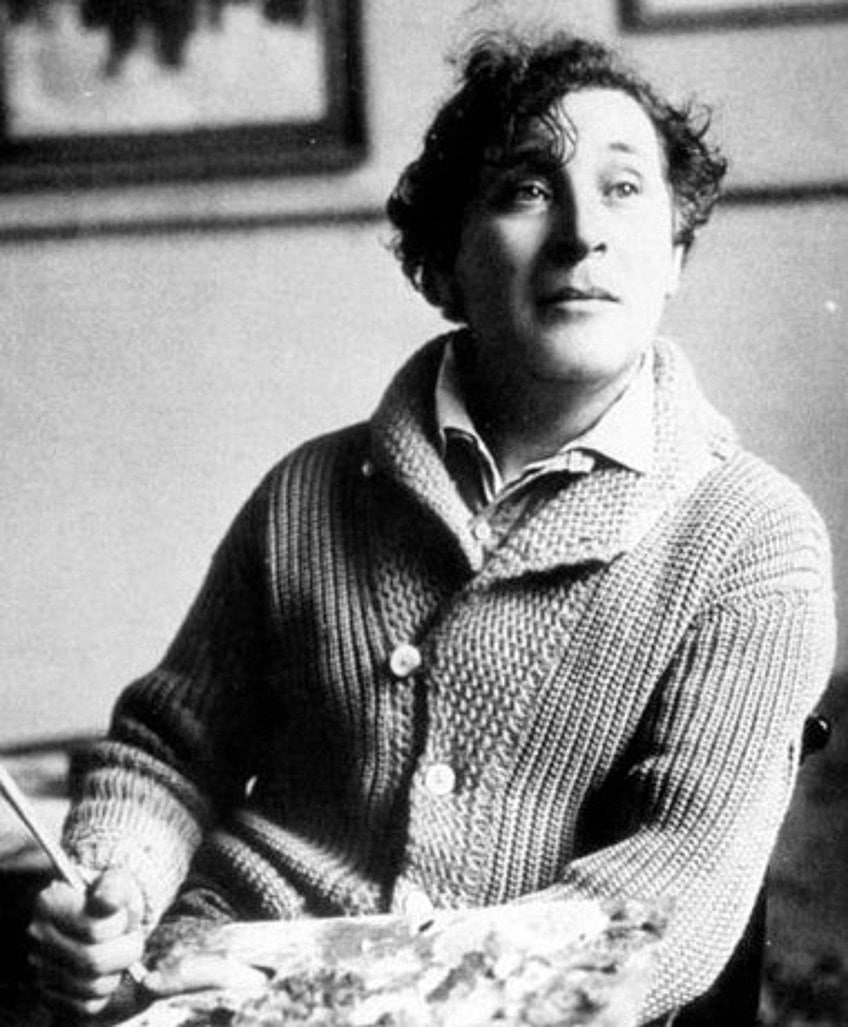
Witnessing someone’s sketch “was like a revelation, an epiphany in black and white” for the adolescent Chagall. Chagall subsequently stated that there was no artwork of any type in his family’s house and that the notion was completely foreign to him. When Chagall asked a classmate how he learned to sketch, the student answered, “Go get a book from the library, fool, pick any image you like, and simply duplicate it.”
He quickly started reproducing pictures from books and found the process so fulfilling that it swiftly blossomed into a passion for painting and the resolve to explore it as a vocation, which did not delight his parents.
Education
In 1906, Chagall commenced his studies with Yehuda Pen, who ran an all-Jewish exclusive institution in Vitebsk for painting and drawing pupils. Despite his gratitude for the free academic education, Chagall departed the institution after a few months. Chagall traveled to St. Petersburg the following year to pursue his studies, where he temporarily worked under the set designer and artist Léon Bakst. Bakst, a devoted Jew himself, is said to have pushed Chagall to include Jewish symbols and ideas in his works, which was controversial at the time, particularly given the Russian Empire’s intolerance to the faith.
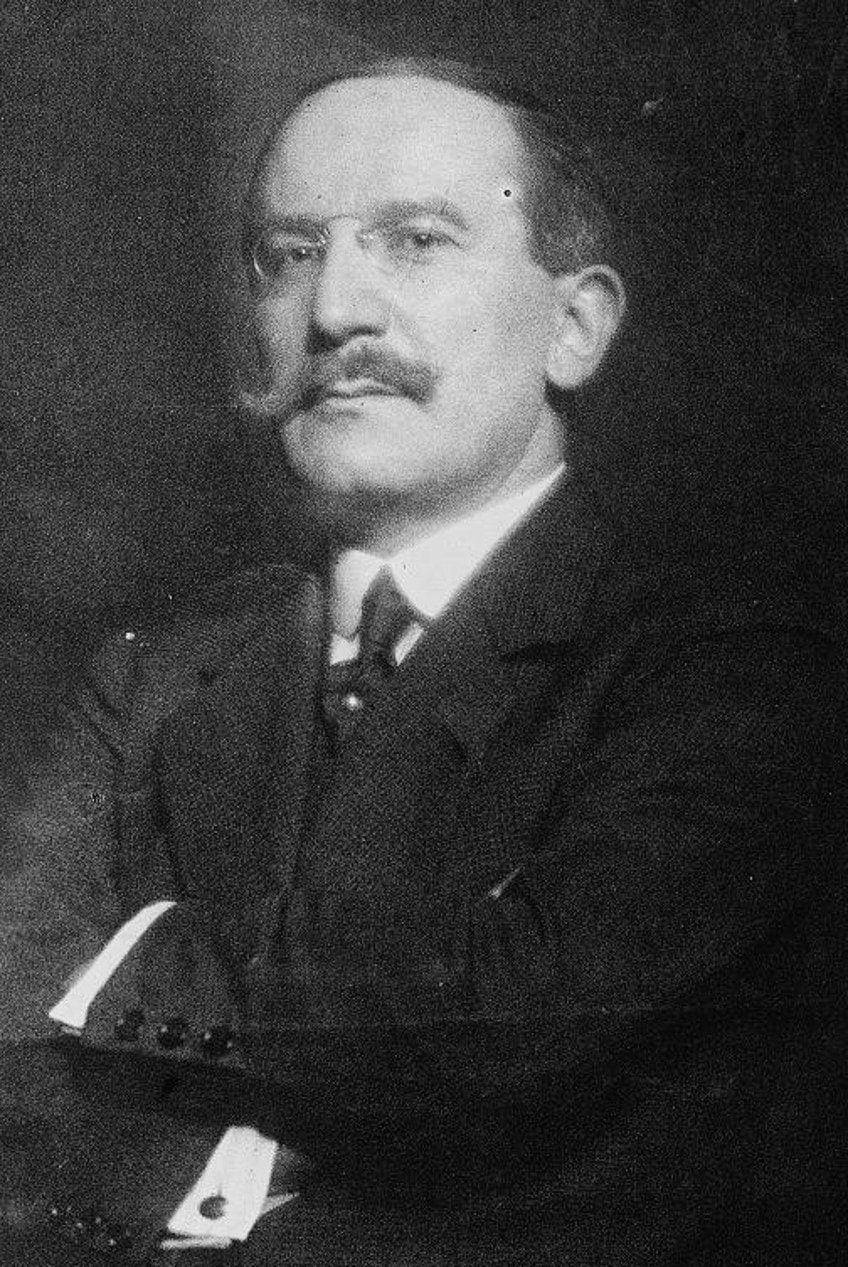
During this time period in Imperial Russia, Jewish people had two main options for entering the world of art: One was to “conceal or reject one’s Jewish ancestry.” The second option, which Chagall embraced, was to “celebrate and openly proclaim one’s Jewish ancestry” by incorporating them into his paintings. This was also a form of “self-assertion and a declaration of conviction” for Chagall.
With the links between his work and his formative years, the Hasidic attitude remains the foundation and wellspring of sustenance for his work.
As multicultural an artist, as he would subsequently become, his imagery depository would never broaden beyond the scenery of his early life, with its snowy sidewalks, old buildings, and omnipresent pipers with images of adolescence so indelible in one’s psyche and to engage them with a sentimental power so profound that it could only be released subtly through an excessive rehearsal of the same enigmatic emblems and icons.
Career
Chagall’s oeuvre spanned many decades. Due to the political upheavals of his time, he moved frequently from one country to another. We will now explore how his career developed over time and in different locations around the world.
1906 – 1910 (Russian Empire)
Chagall relocated to Saint Petersburg in 1906, the center of the Russian Empire at the time and the heart of the nation’s cultural life, with its renowned art institutions. He obtained a provisional passport from a colleague because Jews were not authorized to enter the capital without an interior passport. He registered at a prominent art school and spent two years there. He had begun painting realistic landscapes and self-portraits by 1907.
Chagall was a fellow of the Grand Orient of Russia’s Peoples, an unusual Freemason organization. He was a member of the “Vitebsk” lodge.

Painter Chagall studied at the Zvantseva School of Drawing and Painting under Léon Bakst between 1908 and 1910. While in Saint Petersburg, he became acquainted with unconventional plays and the works of painters such as Paul Gauguin. Bakst, who was also Jewish, was a decorative artist who was well-known as a designer of stage costume designs for the Ballets Russes.
He aided Chagall by serving as a good example for Jewish achievement.
A year later, Bakst relocated to Paris. Chagall reached the center of modern art after studying art on his own for approximately four years. Russia had played a noteworthy early part in his life, even though his apprenticeship was done.

Marc Chagall remained in Saint Petersburg until around 1910, returning frequently to Vitebsk, where he encountered Bella Rosenfeld. Chagall recounted his first interaction with her “Her quiet is also mine, her eyes are mine too.” It is as if she understands all about my past, present, and also my future, as though she was able to peer right through me.”
“When one did obtain a peek of his eyes, they were as blue as if they’d dropped down from the sky,” Bella subsequently wrote upon seeing him.
1910 – 1914 (France)
Chagall moved to Paris in 1910 to further develop his creative style. When Chagall first came to Paris, Cubism was the prominent art style, and French art was still influenced by the superficial worldview of the 19th century. Chagall, on the other hand, came from Russia with “a rich color talent, a fresh, uninhibited reaction to emotions, a taste for uncomplicated poetry, and a sense of humor,” he says. These ideas were foreign to Paris at the time, and as a consequence, his initial acclaim came from poets such as Guillaume Apollinaire, rather than other artists.
Chagall started conceiving of art as “coming from the interior being outwards, from the observed object to the mental outflow,” which was the polar opposite of the Cubist approach to creation.
As a result, he became acquainted with Guillaume Apollinaire and other avant-garde painters like Fernand Léger. His first days in Paris were difficult for Chagall, who was alone in the vast city and not able to communicate in French. On certain days, he “felt like running back to Russia” as he “fantasized when painting about the treasures of Slavic mythology, his Hasidic memories, his relatives, and particularly Bella.” Chagall was ecstatic, drunk as he went through the neighborhoods and along the Seine’s banks.
Everything about Paris piqued his interest: the stores, the scent of freshly baked bread in the mornings, the marketplaces with their fresh produce, the vast plazas, the restaurants and bars, and, of course, the Eiffel Tower. The swirl of hues and textures in the paintings of French painters opened up an entirely new universe for him.
Chagall passionately evaluated their many inclinations, forcing him to reconsider his stance as a painter and select which artistic direction he wanted to explore.
Chagall created a slew of eccentric images, including phantom beings hovering in the sky, a colossal violinist playing on tiny dollhouses, cattle, and translucent wombs with small young children resting inverted. The bulk of his Vitebsk images were produced when he was living in Paris, and they were, in some ways, fantasies. With a disconnected and abstract look, they have an undercurrent of desire and sorrow. His hybrids and aerial phantoms would have a lasting impact on Surrealism.

Chagall, on the other hand, did not want his works to be connected with any style or group, and he saw his own distinctive lexicon of symbols as important to himself. Others frequently identify his works with irrational and surreal art, particularly when he employs unusual pictorial paradoxes. This is Chagall’s legacy to modern art: a reemergence of the poetry of depiction that avoids factual depiction on the one side and non-figurative abstractions on another. The metaphor triumphantly returned to contemporary art with him alone, according to a historian. During this period, he created artworks such as I and the Village (1911) and Paris Through the Window (1913).
1914 – 1922 (Soviet Belarus)
Due to missing Bella, Chagall accepted an offer to display his work in Berlin, intending to carry on to Belarus, wed Bella, and afterward return to Paris beside her. Chagall displayed 160 gouaches, sketches, and watercolors, as well as 40 canvases. The exhibition, which took place at Herwarth Walden’s Sturm Gallery, was a major triumph, with “the German reviewers favorably singing his virtues.” Following the exhibition, he traveled to Vitebsk, where he intended to remain only long enough just to marry Bella.
However, the First World War broke out a few weeks later, sealing the Russian border indefinitely.
They were concerned that she would marry an artist from a low-income family and that he would be unable to support her. Becoming a professional painter has now become a goal and source of inspiration for him. Chagall began displaying his works in Moscow in 1915, initially at a well-known gallery and then in St. Petersburg in 1916. In 1917, he illustrated I. L. Peretz’s The Magician, and also produced Bella with White Collar (1917).
The October Revolution of 1917 was a perilous period for Chagall, but it also provided opportunities. He was already one of Imperial Russia’s most renowned painters and a component of the modernist avant-garde, which had unique rights and status as the revolution’s “cultural branch.”
He took a position as Vitebsk’s art director. As a result, he established the Vitebsk Arts College, which grew to become the most prestigious art institution in the Soviet Union. The World War had ended in 1918, but the Russian Civil War and starvation endured. After living in squalor for two years between 1921 and 1922, he chose to return to France to further his work in a more pleasant setting.
Many other painters, authors, and musicians planned to migrate to the West as well. He filed for an exit visa and penned his memoirs while waiting for its dubious acceptance.
1923 – 1941 (France)
Chagall left Moscow in 1923 to go back to France. On his route, he stopped in Berlin to retrieve the numerous images he had placed on display there 10 years before the war started, but he failed to discover or reclaim any of them. Nevertheless, after moving to Paris, he regained the freedom and satisfaction that were so important to him. With all of his pioneering pioneers now destroyed, he resumed sketching and painting from his recollections of his formative days in Vitebsk. Around this period, he produced Green Violinist (1924).
He established a commercial partnership with Ambroise Vollard, a French art dealer. This prompted him to start making illustrations for a set of illustrated volumes, the pictures of which would later come to constitute his best printing work, including La Fontaine’s Fables (1668 – 1694). He toured around France and the Côte d’Azur at this time, enjoying the scenery, colorful flora, the turquoise Coastline, and the balmy weather. He went to the country on several occasions, bringing his sketchbook with him. He also traveled to neighboring nations and subsequently wrote about the impact that some of his adventures left on him.
Vollard commissioned Chagall to depict the Old Testament after returning to Paris after one of his journeys.
Even though he could have performed the research in France, he took the task as an opportunity to visit Israel and see the Holy Land firsthand. As a consequence, he became engrossed in Jewish history, including their hardships, predictions, and calamities. He had finally established himself as a leading contemporary artist, yet he was about to abandon his modernist subjects and dig into the deep history. When he arrived back in France, he produced 32 of the 105 pieces by the following year. He also created the White Crucifixion (1938) in this period of his life.
Adolf Hitler came to control in Germany not much after Chagall started his production on the Bible. Anti-Semitic legislation was being enacted, and the first concentration camp had been built. immediately after the Nazis took control, they launched a crusade targeting contemporary art.
Expressionist, surrealist, abstract, and cubist art was attacked, as was everything scholarly, Jewish, cosmopolitan, socialist-inspired, or challenging to grasp. Everyone was taken aback by the rapidity with which France imploded.
Chagall’s life was rescued when his name was included in a list of notable artists whose lives were in danger and from whom the United States should endeavor to free them. The Chagalls were detained in Marseille while staying at a hotel with other Jews. Varian Fry was able to persuade the French authorities to free him by scaring them with a controversy. This effort saved almost 2,000 people, including Marc Chagall.
1941 – 1948 (United States)
Chagall was given the Carnegie Place third prize in 1939 for Les Fiancés (1929) even before coming to the United States in 1941. After arriving in America, he realized that he had already attained universal prominence, despite feeling ill-suited to this new post in a strange nation whose tongue he did not yet know. He became a sensation mostly without his desire since he felt disoriented in his unfamiliar circumstances.
After a while, he started to feel comfortable in New York, which was teeming with authors, artists, and musicians who had left Europe following the Nazi attacks. Modern artists have yet to comprehend, let alone appreciate, Chagall’s work.

However, opinions began to shift when Henri Matisse’s son, Pierre, became his agent and oversaw Chagall’s exhibits. However, once Chagall returned to New York in 1943, contemporary events began to pique his attention, and this was reflected in his work, where he painted topics like The Yellow Crucifixion (1943) and combat scenes. He was profoundly concerned when he learned that the Germans had devastated Vitebsk, the village where he was nurtured. He also became aware of the Nazi death camps.
Bella died abruptly on the 2nd of September, 1944, as a result of a viral infection that was not addressed owing to a lack of medication during the war. As a consequence, he took a break from painting for several months, and then when he did start, his initial paintings were preoccupied with maintaining Bella’s memory. He began a relationship with Virginia Haggard after a year of living with his daughter and her husband. They had a baby together during their seven-year relationship.
By 1946, his artwork was growing more well-known.

The Museum of Modern Art in New York hosted a big show covering 40 years of his oeuvre, giving viewers one of the first thorough insights into the completely changing style of his work over the years. The conflict was over, and he began making preparations to return to Paris. He discovered he was much more strongly connected than previously, not only to the ambiance of Paris but to the place itself, to its buildings and its vistas.
1948 – 1985 (France)
Upon returning back to France, he went around Europe and opted to reside on the Côte d’Azur, which had become something of an “arts center” at that time, with artists such as Picasso and Matisse living nearby. Despite the fact that they lived close and occasionally worked together, there was creative competitiveness between them since their work was so dissimilar, and they never established a long-term friendship. He was able to create not just canvases and graphic art, but also several statues and ceramic pieces including painted vases, wall tiles, and plates, in the years that followed.
He also began to work on greater scales, creating enormous stained-glass windows, murals, tapestries, and mosaics.
Chagall was selected in 1963 to decorate the new ceiling for the Paris Opera, a magnificent 19th-century structure and historic site. France’s Minister of Culture, desired something one-of-a-kind and determined that Chagall would be the right artist.

Yet, the pick of the artist sparked a debate: some opposed a Russian Jew decorating a French national landmark, while others were opposed to a contemporary artist painting the old building’s ceiling. Despite this, Chagall persevered with the task, which took a year to finish. After the new ceiling was announced, “even the commission’s most ardent adversaries seemed to fall mute.” Around this time, he also created the magnificent Peace Window (1967).

By the period he actually died in France in 1985, he had personally witnessed the Russian revolution’s high hopes and crushing discouragements, as well as the completion of the Settlement, the near obliteration of European Jewry, and the total annihilation of his hometown. Chagall’s final painting was a contract for the Rehabilitation Institute of Chicago. The painting named Job (1985) was finished, but Chagall died soon before the tapestry was finished.
Marc Chagall’s Art Style Characteristics
The colors in all of Chagall’s paintings, at all times of his life, drew the visitor in. During his younger years, his breadth was restricted by his attention to form, and his paintings never looked like painted drawings. The colors are alive, an essential part of the image, never merely flat or dull as an addition. They bring the volume of the forms to life.
They engage in imaginative and imaginative flights of fantasy, which bring fresh viewpoints and graded, blended tones.
His colors don’t even try to replicate nature; instead, they evoke emotions, planes, and patterns. He was able to create eye-catching pictures using only two or three tones. Chagall is unrivaled in his capacity to create a strong impression of motion with only a few colors. During his life, his colors helped to create a “thriving ambiance” based on “his own particular view.”

Subject Matter of Marc Chagall’s Paintings
Chagall’s upbringing instilled in him a strong visual recall and a pictorial acumen. His imagination skyrocketed after living in France and witnessing the spirit of artistic liberty, and he built a new existence that drew on both his inner and exterior worlds. However, it was the pictures and recollections of his childhood in Belarus that would feed his creativity for more than 70 years. Certain characteristics in his paintings have stayed constant and visible throughout his tenure. One of these was his selection of topics and the manner in which they were shown.
“The most evident continuous aspect is his talent for happiness and natural compassion, which stops him from dramatizing even the most serious issues.”
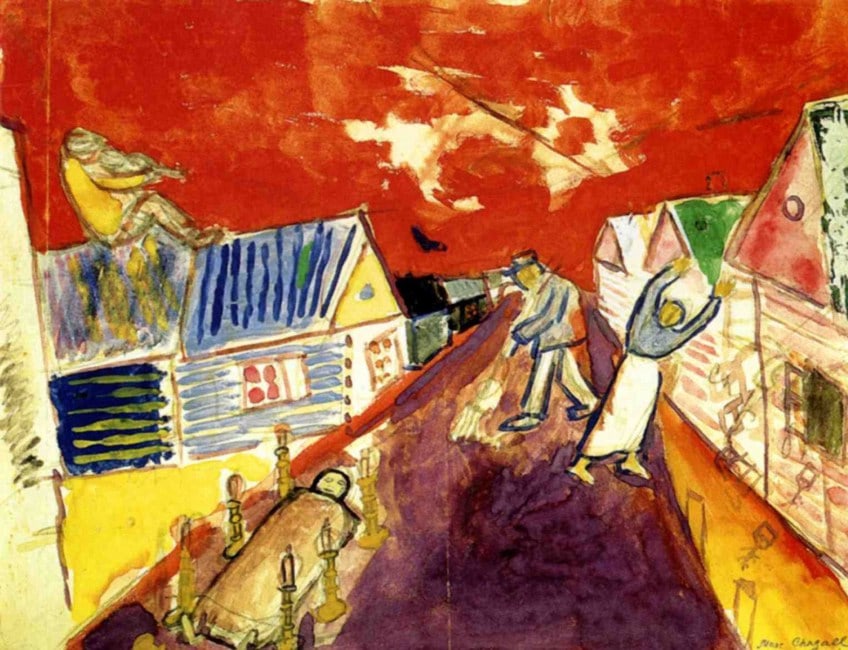
Music has been a constant throughout his career. “Lovers have sought each other, clasped, stroked, drifted in the air, met in garlands of flowers, extended, and swooped like the musical course of their bright daydreams,” he wrote after his first marriage. Acrobats twist around with the elegance of exotic blooms on the tips of their shafts; flowers and greenery proliferate. Clowns and aerialists always reminded him of characters in religious art.
The progression of his circus paintings indicates a progressive clouding of his perspective, and the entertainers in his works now gave way to the prophetic character into whom Chagall channeled his worry as Europe blackened and he could no longer depend on France’s feeling of liberty for creativity.
His early images were frequently of Vitebsk, the region where he was born and nurtured. They are lifelike and offer the feeling of direct experience by recording a point in time with activity, frequently accompanied by a striking visual. Some of these artworks include Snow, Winter in Vitebsk (1911). Subjects became increasingly melodramatic in his final years, as shown in the Bible series. He was able to merge the real with the surreal, and his use of color ensured that his images were always at least passable, if not overwhelming. He never tried to depict pure truth, instead of creating his ambiance through fiction.
Life itself, in its purity or concealed depth, is Chagall’s most consistent topic in all of his works. He shows us locations, people, and items from his own life for our consideration.
Chagall was able to merge Cubism and Fauvism methods with his own folkish style after studying Cubism and Fauvism skills. He imbued the bleak lives of Hasidic Jews with the magical connotations of an enchanted realm. He was able to capture the interest of academics and collectors around Europe by mixing characteristics of Modernism with his “own aesthetic language.” In general, his childhood in a Belarussian provincial town provided him with a constant stream of inventive stimulation. Chagall would go on to become one of many Jewish émigrés who went on to become well-known painters, all of whom had previously been members of Russia’s most numerous and creative minority.
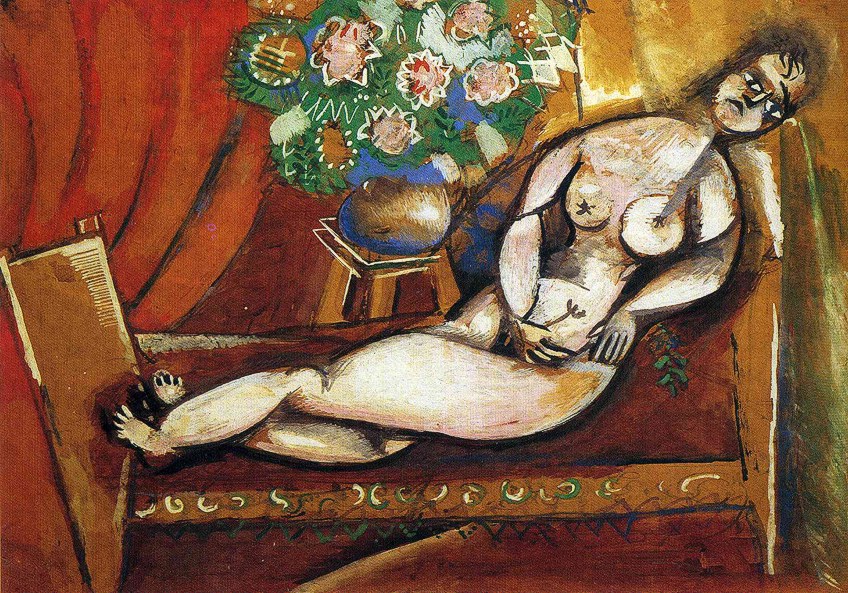
Chagall is regarded as the most significant fine artist to have bear testimony to the reality of East European Jewry, accidentally becoming the public witness of a now-disappearing civilization. Despite religious hang-ups regarding pictorial art depicting numerous religious issues, Chagall was able to employ his fantasy pictures as a type of graphic metaphor coupled with traditional imagery. His Fiddler on the Roof (1912), for instance, blends a folky village backdrop with a fiddler to demonstrate how essential music is to the Jewish character.
Music has a significant influence on the themes of his work.
While he eventually came to appreciate the melodies of Bach and Mozart, he was most inspired by the songs of the Hasidic neighborhood in which he grew up. According to art historian Franz Meyer, one of the key causes for his work’s unorthodox nature is tied to Hasidism, which influenced the culture of his boyhood and adolescence and had truly imposed itself on most Eastern European Jews ever since the 18th century.
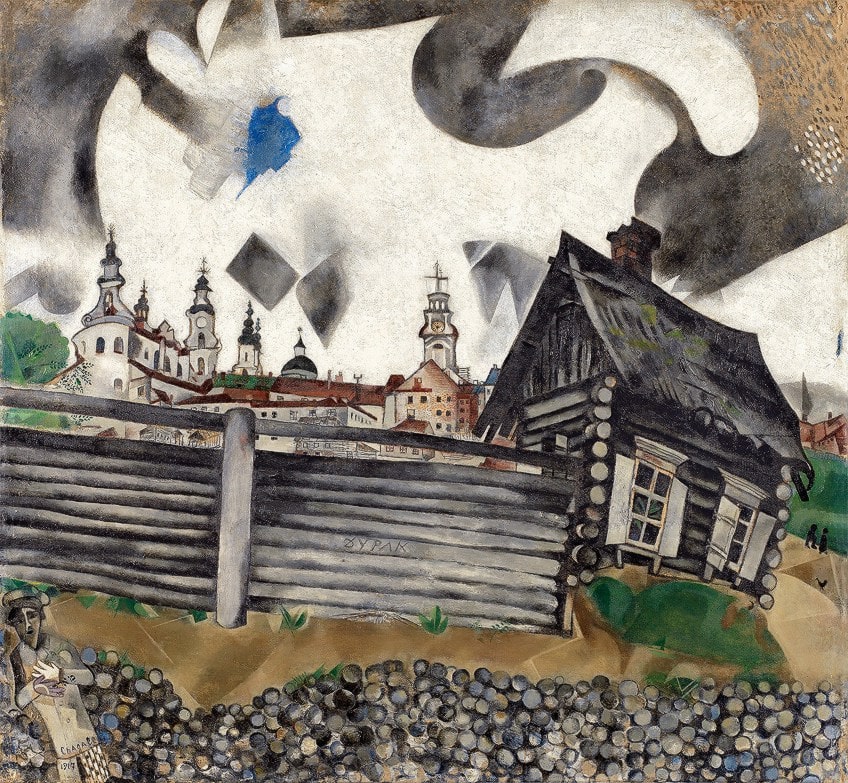
For Chagall, this is one of the most profound sources, not of creativity, but of a specific spiritual mentality; the Hasidic spirit remains the foundation and source of nutrition for his art. Chagall, on the other hand, had a complicated connection with Judaism. On the one hand, he attributed his artistic creativity to his Russian Jewish ethnic heritage.
But, no matter how conflicted he felt about his faith, he couldn’t help but rely on his Jewish heritage for creative inspiration. He was not an observant Jew as an adult, but via his artworks and stained glass, he wanted to convey a more “universal statement” by incorporating Christian and Jewish motifs.
Chagall’s Other Types of Art
Marc Chagall’s paintings brought him worldwide fame. Yet it was not the only medium he enjoyed working with. Here are some other artistic ventures he explored.
Stained Glass
His creation with stained glass was one of Chagall’s most significant contributions to art. This medium enabled him to convey his ambition to produce bright and vivid colors even further, and it had the added bonus of natural daylight and refraction combining and always changing: anything from the viewer’s location to the weather would affect the visual impression. It wasn’t until he was around 70 years old, in 1956, that he created windows for the Assy church, his first big endeavor. He worked on windows for Metz Cathedral from 1958 until 1960.
Stage Design
Chagall began designing stage sets in 1914 while residing in Russia, inspired by the theater designer Léon Bakst. it was during this time in Russian theatre that previously static conceptions of stage design were transformed “being washed away in favor of a completely random sense of space with various dimensions, viewpoints, colors, and rhythms.
These modifications appealed to Chagall, who had been dabbling with Cubism and was looking for a means to bring his pictures to life. Chagall’s work includes murals and stage designs.
As a result, Chagall played an essential part in Russian cultural life at the time, serving as “one of the most vital roles in the contemporary impulse towards anti-realism,” assisting the new Russia in inventing “incredible” masterpieces.
Tapestries
Chagall also created tapestries, which were embroidered by Yvette Cauquil-Prince, who had worked with Picasso. Only 40 of these tapestries have ever been sold commercially, making them far rarer than his canvases. He created three tapestries for Israel’s Knesset’s state hall, as well as 12-floor mosaics, and finally a wall mosaic as well.

Sculpture and Ceramics
While residing in southern France, Chagall began studying ceramics and sculpting. Ceramics were popular on the Côte d’Azur, with new studios springing up in Antibes, and Vallauris. He studied among other well-known painters such as Pablo Picasso and Fernand Léger. Chagall began by painting pre-existing items of pottery but quickly moved on to create his own, which led to his career as a sculptor as a complement to his paintings. After dabbling with ceramics and plates, he progressed to big ceramic murals.
Nevertheless, he was never content with the constraints imposed by the square tile segments, which forced him to exercise discipline in order to create a plastic image.
The Influence and Legacy of Marc Chagall’s Art Style
Chagall was a contemporary art pioneer and one of its best figurative painters, inventing a visual language that captured the excitement and fear of the 20th century. In his works, we see the victory of modernism, a leap in the arts to an embodiment of inner life that is one of the 20th century’s most significant legacies. Chagall was intimately swept up in the tragedies of European history: revolutions, ethnic discrimination, the slaughter and banishment of millions.
In an era when many famous painters eschewed reality in favor of abstraction, he condensed his experiences of grief and tragedy into pictures that were at once direct, simple, and meaningful, to which anybody could relate.
Chagall was a painter, a visionary, and a mysterious presence. His serene figures and modest movements contributed to a tremendous feeling of dignity by transforming common Jewish traditions into a timeless domain of iconic tranquility.
Chagall’s Exhibitions and Tributes
Due to his worldwide recognition and the appeal of his artwork, a number of nations have produced commemorative stamps displaying examples of his paintings in his celebration. France produced a stamp using his picture, The Married Couple of the Eiffel Tower (1939), in 1963. In 1987, seven nations collaborated on a unique comprehensive project and issued postage stamps in his tribute to commemorate the centennial of his birth in Belarus. Some of the artists noted exhibitions include:
- Message Biblique Exhibition at the Louvre Paris in 1967
- Hommage a Marc Chagall exhibition at the Grand Palais from 1969 until 1970
- The Tretyakov Gallery in Moscow in 1973
- Chagall of Miracles exhibition at Complesso del Vittoriano in Rome, 2007
- Chagall and the Bible at The Musée d’art et d’histoire du judaïsme in Paris, 2011
Notable Marc Chagall Paintings
Marc Chagall’s paintings are renowned across the globe. He had a very long and complex career as an artist. We have compiled a list of some of his most well-loved works.
- To my Betrothed (1911)
- I and the Village (1911)
- The Holy Coachmen (1912)
- The Gates of the Cemetery (1917)
- White Crucifixion (1938)
- Green Violinist (1924)
- America Windows (1977)
- The Three Candles (1940)
- Cow with Parasol (1946)
- Bouquet with Flying Lovers (1947)
Book Recommendations
Painter Marc Chagall lived a long life and created many artworks. If you would like to learn more about the artist after reading this article, then we can suggest a few books that will give you an even deeper insight into Marc Chagall’s biography and artworks. Here is our pick:
Marc Chagall: My Life (1994) by Marc Chagall
This fascinating autobiography was written by Chagall in Moscow in 1922 when he was 35 years old. Despite being out of print for a long time, it remains one of the most extraordinary and wonderfully recounted autobiographies ever written. The narrative is complemented by 20 plates created by Chagall specifically to tell his life story. Combined, the words and images provide an extraordinary depiction of one of the 20th century’s finest painters, as well as the now-vanished environment that inspired him.
- Written by Chagall in Moscow when the artist was 35 years old
- An extraordinarily inventive and beautifully told autobiography
- Accompanied by 20 specially-prepared plates to illustrate his story
Marc Chagall: 1887-1985 (2008) by Jacob Baal-Teshuva
Marc Chagall, without a doubt one of the finest painters of the 20th century, developed a unique universe full of tragedy, poetry, comedy, and magic, relying on deep recollections of his Jewish upbringing in Russia. Despite the major trends and schools of 20th-century art that he witnessed forming around him, his own style and link to the past lasted throughout his seven-decade tenure. This exhibition covers all areas of Chagall’s art, from canvases to tapestries, stained glass, ceramics, and more.
- A look at one of the greatest artists of the 20th century
- This book covers all aspects of Marc Chagall's works
- From paintings and stained glass to tapestries, ceramics, and more
Marc Chagall’s elegant, figurative style placed him as one of the most admired visual artists, and his diversified output positioned him as one of the most widely known. Despite many of his contemporaries experimenting in extravagant ways that occasionally led to abstraction, painter Marc Chagall’s defining quality was his everlasting faith in the power of figurative art, which he maintained while adopting Cubist and Fauvist notions. Marc Chagall’s paintings were created in a variety of modern genres such as Surrealism, Suprematism, and Cubism.
Frequently Asked Questions
How Much Is a Marc Chagall Lithograph Worth?
You might not be interested in the aesthetics of Chagall’s paintings. But how much is a Marc Chagall Lithograph worth? Online reports estimate that one might be worth around $8,000 to $10,000.
Where Was Marc Chagall Born?
Painter Chagall was originally from Russia. He then later moved to France and the United States of America. He was a Russian Jew and wanted to display his pride through his artworks. His Jewish culture was fundamental to him, and most of his work might be defined as an endeavor to integrate historic Jewish practices with modern art forms. He did, however, draw on Christian subjects occasionally, which suited his penchant for narrative and metaphor.
What Is Marc Chagall Most Known For?
Chagall experimented with a variety of extreme modernist forms during his career, including Suprematism, Cubism, and Surrealism, all of which may have influenced him to paint in a fully abstract style. Nonetheless, he spurned each of them in turn, remained dedicated to representational and narrative painting, making him one of the most renowned supporters of the more conventional style in the contemporary time. Marc Chagall’s dramatic, pictorial approach established him as one of the most popular modern painters, and his long life and diverse production established him as one of the most widely renowned.
Isabella studied at the University of Cape Town in South Africa and graduated with a Bachelor of Arts majoring in English Literature & Language and Psychology. Throughout her undergraduate years, she took Art History as an additional subject and absolutely loved it. Building on from her art history knowledge that began in high school, art has always been a particular area of fascination for her. From learning about artworks previously unknown to her, or sharpening her existing understanding of specific works, the ability to continue learning within this interesting sphere excites her greatly.
Her focal points of interest in art history encompass profiling specific artists and art movements, as it is these areas where she is able to really dig deep into the rich narrative of the art world. Additionally, she particularly enjoys exploring the different artistic styles of the 20th century, as well as the important impact that female artists have had on the development of art history.
Learn more about Isabella Meyer and the Art in Context Team.
Cite this Article
Isabella, Meyer, “Marc Chagall – His Cubist, Fauvist, and Surrealist Dreamworlds.” Art in Context. February 15, 2022. URL: https://artincontext.org/marc-chagall/
Meyer, I. (2022, 15 February). Marc Chagall – His Cubist, Fauvist, and Surrealist Dreamworlds. Art in Context. https://artincontext.org/marc-chagall/
Meyer, Isabella. “Marc Chagall – His Cubist, Fauvist, and Surrealist Dreamworlds.” Art in Context, February 15, 2022. https://artincontext.org/marc-chagall/.







